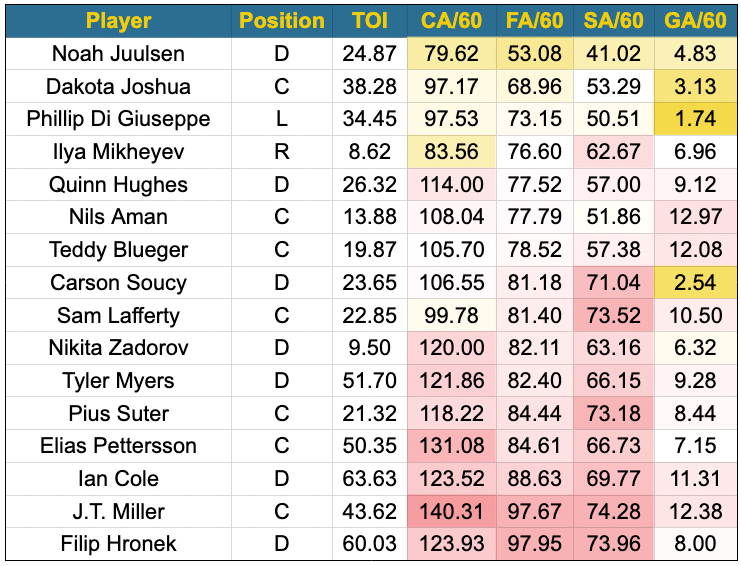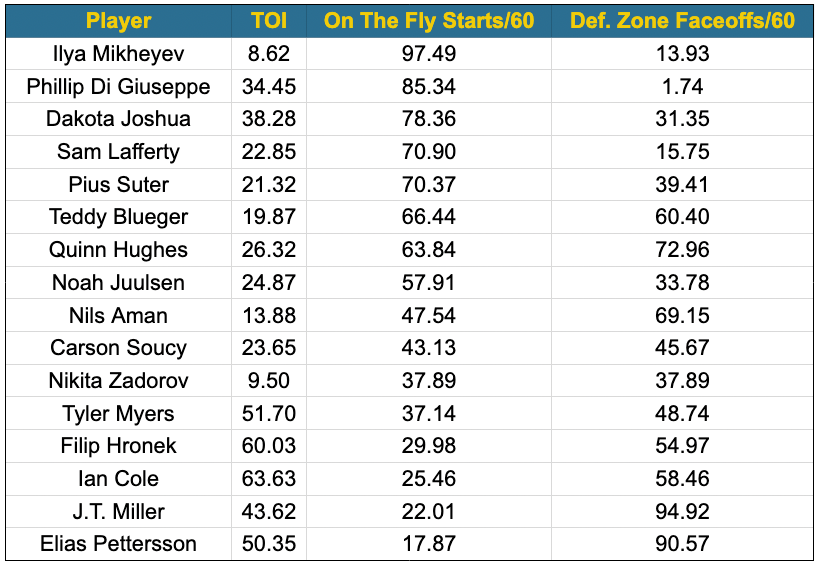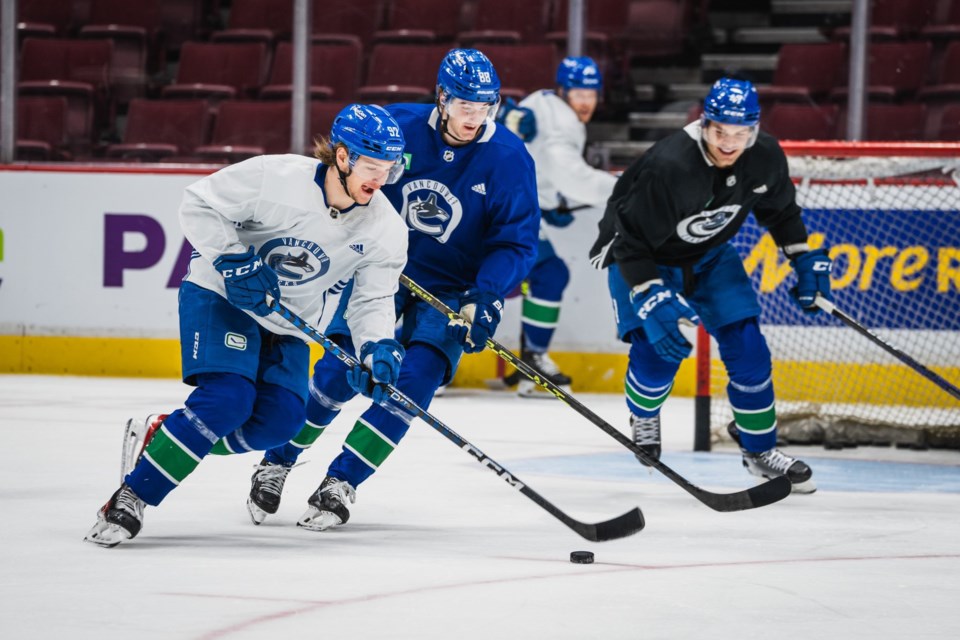The Vancouver Canucks’ penalty kill isn’t exactly good but it’s a lot better than it used to be.
Last season, the Canucks had the worst penalty kill percentage in the NHL at 71.6%. It wasn’t the worst penalty kill in history like it was trending to be — it wasn’t even the worst penalty kill in Canucks history — but it landed in the bottom ten all-time.
This season, the Canucks are at least not threatening to make history. At 75.0%, the penalty kill is ranked 27th in the NHL and they’ve given up the fifth-most power play goals against, but at least the penalty kill is no longer actively costing the Canucks games the way it did last season.
There’s also no denying that the penalty kill simply looks better, no longer giving up the dangerous cross-seam passes that left the team’s goaltenders high and dry. A big portion of that is systems-related, as the Canucks have moved from a wedge+1 formation — two defencemen down low, one forward in the slot, and a free-roaming forward across the top — to a diamond that sees one defenceman at the net front, a forward and a defenceman at the sides, and a forward at the top.
Canucks head coach Rick Tocchet said it’s not a strict diamond, however.
“The diamond intrigues me a little bit,” said Tocchet at the start of the season. “I think we’re a little bit more of a hybrid, we’re not actually a total diamond but it seems like a diamond. We don’t leave the middle open too much but we’ve got a lot more aggressiveness, which I like.”
A more in-depth look at the team’s penalty kill system is on the way but it’s not just the change to the systems that has helped the penalty kill improve, even if it still needs work.
“There is some system stuff that we’re doing but I think some personnel has helped too,” said Tocchet.
So, who are the Canucks’ penalty killers and, more importantly, who’s doing well on the penalty kill and who is struggling?
Running the numbers on the Canucks penalty kill
Here are all of the Canucks’ penalty killers who have spent even five minutes at 4-on-5 this season. That means a very small sample size for both Ilya Mikheyev and Nikita Zadorov, so keep that in mind.

You can view the same data a little more dynamically on this stacked bar chart, which lets you sort out the shot attempts you don’t care about from the ones you do and see where each Canucks penalty killer ranks.
The statistics used here are corsi (shot attempts), fenwick (unblocked shot attempts), shots, and goals, all as a rate per 60 minutes of ice time. They are coloured by how they compare to the league average in each statistic and ranked by fenwick against, which is the statistic I lean towards when evaluating individual penalty killers.
Is Noah Juulsen the Canucks' best penalty killer?
A surprising name leads the way not just in fenwick but in three of these statistical categories: Noah Juulsen. That perhaps answers a question posed a few weeks ago about why Juulsen is still in the Canucks’ lineup. For all his deficiencies at 5-on-5, he has been very effective on the penalty kill.
It makes some sense. Juulsen’s strengths lie in his physical play in front of the net, his willingness to block shots, and his adherence to the structure preached by the coaching staff, all of which are key to the penalty kill. His weaknesses — his mobility, ability to defend the rush, decision-making with the puck, and passing — don’t generally come into play on the penalty kill. When a penalty killer gets the puck, the decision-making is generally limited to one option: clear the puck the length of the ice.
A couple of forwards rank quite highly as well: Dakota Joshua and Phil Di Giuseppe. Both lead the way in the lowest rate of goals against among Canucks forwards and they’re coming by that statistic honestly, with the lowest rates of unblocked shots against behind Juulsen.
That’s about it when it comes to penalty killers performing above average, unfortunately. Ilya Mikheyev, Quinn Hughes, Nils Åman, and Teddy Blueger are right around average in unblocked shot attempts against, though Åman and Blueger have been on for a concerningly high rate of goals against.
Are J.T. Miller and Elias Pettersson the Canucks' worst penalty killers?
The real issue appears to be with the Canucks’ most-used penalty killers, who have all been on the ice for the highest rate of shot attempts, unblocked shot attempts, and shots on goal against.
The numbers are particularly troubling for J.T. Miller, who has been on the ice for the highest or second-highest rate of shot attempts, unblocked shot attempts, shots on goal, and goals against at 4-on-5. The numbers for Elias Pettersson, Ian Cole, and Filip Hronek aren’t great either.
To be fair, the most-used penalty killers are more likely to regularly face the opposition’s top power play unit while starting shifts in the defensive zone. The latter is definitely true for Miller and Pettersson, who have been on the ice for the highest rate of defensive zone faceoffs on the penalty kill.

It's also worth noting that separating out penalty killers' individual contributions is a challenge as killing a penalty is a team effort. While both Miller and Pettersson's numbers on the penalty kill aren't great, they've also been on the ice together a lot, so which of the two is to blame for those numbers?
Meanwhile, Mikheyev, Di Giuseppe, and Joshua have started the vast majority of their penalty killing shifts on the fly, which means they’re coming onto the ice when the puck has already been cleared out of the defensive zone. That means they have the advantage of potentially stopping the opposing power play at the blue line and preventing them from ever getting set up in the offensive zone.
Penalty killers starting on the fly might also be facing the opposition’s second power play unit more often as well, which is an easier task than shutting down a team’s top unit.
Even with those caveats, however, it’s not ideal that the Canucks’ go-to penalty killers give up such a high number of shots. When the penalty kill is near the bottom of the league, something isn’t quite right.
At the very least, it seems worth trying something different.
The Canucks are trying something different
It’s possible that the Canucks coaching staff see the same issue, as there’s been an interesting trend over the last couple of games: Pettersson and Miller are seeing a lot less time on the penalty kill.
The Canucks had just one penalty to kill against the Minnesota Wild last week. Teddy Blueger and Nils Åman started that kill, then Dakota Joshua and Phil Di Giuseppe came onto the ice and some combination of those four forwards killed the entire penalty. Miller and Pettersson never set foot on the ice for the entire two-minute kill.
There were more penalties to kill against the Carolina Hurricanes on Saturday. Miller was in the box for one of those penalties but even when he wasn’t in the box, he wasn’t the go-to guy on the kill.
The first penalty kill of the game, Blueger and Åman again started things off, then Joshua and Di Giuseppe. After them came Miller and Pettersson in the third rotation of penalty-killing forwards.
It was the same story later in the game: first Blueger and Åman, then Joshua and Di Giuseppe, with Miller and Pettersson on the third rotation if they even got onto the ice. It seems pretty clear that the Canucks are trying something out.
Notably, the Hurricanes’ lone power play goal on Saturday was scored while Miller and Pettersson were on the ice facing the second power play unit.
We can see how the usage of the Canucks’ penalty-killing forwards has changed over the course of the season on the line chart below.
Blueger’s usage, in particular, has skyrocketed from where he was being used when he first returned to the lineup from injury. Åman has likewise seen his usage grow after being called up from the AHL. Joshua, after a brief lull in usage, has been the third most-used forward on the penalty kill in recent games.
It’s an interesting trend to keep an eye on. Will Pettersson and Miller no longer be go-to penalty killers for the Canucks? And, if so, will the team’s bottom-six forwards be able to step up and improve the penalty kill?
Let's keep in mind, Blueger and Åman have average numbers on the penalty kill so far this season and have been on the ice for a high rate of goals against. Joshua and Di Giuseppe have been far better but neither is a natural centre, who can be relied upon to win faceoffs. There's no guarantee that giving those four bottom-six forwards more ice time will lead to better results on the penalty kill.
But when the penalty kill is ranked near the bottom of the NHL, it's worth trying something new.




